
a web page by Don Roberson |
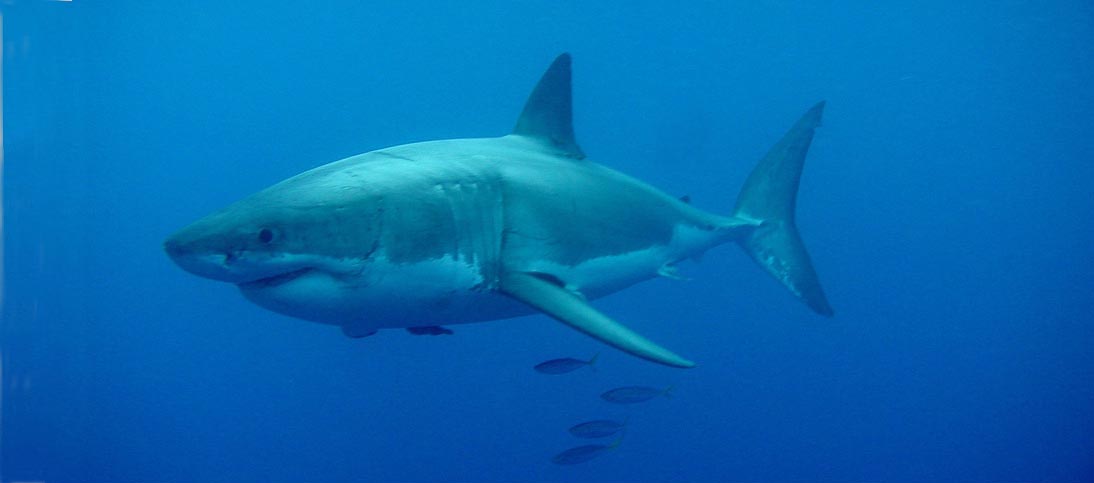 |
||||||
Great White Shark in Oct 2004 at Guadalupe I., Mexico © Chris Hartzell (above, from a cage dive); another Great White Shark in June 1998 at Dyer I., South Africa © Dan Singer (below right) |
||||||
The International Shark Attack File (ISAF) is cited by Carwardine (2002). ISAF investigated 2154 unprovoked shark attacks and found that about 25% proved to be fatal. Great White Shark was by far the primary species confirmed in the fatal attacks. The percentage of attacks attributable to "White Death" has risen in recent years as more humans have been using the shoreline ocean habitat used by Great Whites to hunt their primary prey — pinnipeds (fur seals, elephant seals, sea lions et al.). Most attacks on humans involve surfers, paddle-borders, and others in wet suits on the surface who resemble seals when viewed from below (Great Whites attack from below). Human fatalities would be greater if Great Whites actually hunted people, but many attacks are broken off by sharks when they determine that the prey is not a pinniped. In truth, then, Great Whites are not true 'man-eaters' — they do not view us primarily as meat. Instead, they mistake humans for their actual prey. Still — the image of a Great White Shark headed for you in the water would be entirely terrifying (right). They surely are an apex 'monster of god' in the 'jungles of our mind.' This means that many humans (like me) have a keen desire to encounter a Great White in the wild, but safely. For those willing to get into wet-suits and use SCUBA, cage diving has become a cottage industry at various locales around the globe. Chris Hartzell took the dramatic 'at-sea' underwater shot from a cage off Guadalupe Is., in the Pacific Ocean southwest of Baja California, Mexico [more details and photos on his website]. Cage diving is also offered at several sites near Cape Town, South Africa, such as Dyer Is., where a colony of Southern Fur-Seal provide prey for a population of Great Whites. Tourist boats are anchored near the small island and bait is used to attract sharks. A decade ago it was customary to suspend the bait slightly above the sea surface, enticing sharks to lunge upward, mouth agape, as shown in Dan Singer's photo (above right) from Dyer Is. in 1998. This practice — along with the practice of pulling bait along the surface in hopes of having sharks leap for bait at speed — has since been banned in South Africa as unnatural and possibly detrimental to these sharks, which are declining globally. More recently the baiting is simply floated on or just below the ocean surface, but observers in the cages or remaining on the boat still get very close to huge sharks that swim right next to the boat (my photo from Dyer Is. in 2005 is below). |
||||||
 |
||||||
Great White Shark: July 2005 Dyer I., South Africa © Don Roberson (above) |
||||||
Oceanic Whitetip Shark on 3 Nov 2003 Elphinstoe Reef, Red Sea, Egypt © Thomas Ehrensperger (below; permitted use via Wikipedia Commons) |
||||||
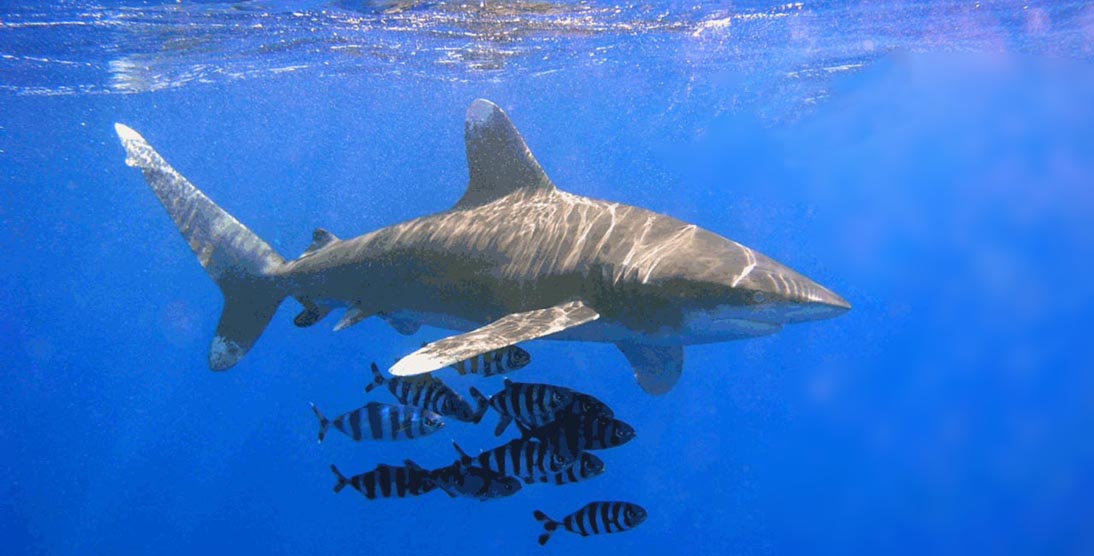 |
||||||
Oceanic Whitetip Shark Carcharhinus longimanus is my choice for the second shark on my 'monsters of god' list. [Quammen (2004) had chosen Ganges Shark Glyphis gangeticus as his second shark, but man-eating is unproven and unlikely in that endangered species. I chose Mugger Crocodile as the substitute for those Indian river systems. Here I chose a second shark as a substitute for Puma Puma concolor.] Oceanic Whitetip is a competitive, opportunistic predator, "rather than avoiding trouble in favor of a potentially easier future meal;" Compagno (1984). It simply conserves energy between infrequent feeding opportunities. "Once they have found food, they can be very aggressive and will dominate other shark species joining in the feast;" Carwardine (2002). Oceanic Whitetip is a large shark (it was once called "Lesser White" to link it with Great White Shark) that can routinely reach about 3m (10 ft) long. The largest was 3.9m (12.7 ft). It is an undoubted 'man-eater' and is probably responsible for more human deaths by shark than any other species. Jacques Cousteau considered it "the most dangerous of all sharks" (Cousteau & Cousteau 1970). Most of the attacks on humans have occurred at shipwrecks or downed aircraft in tropical seas far offshore, and particularly during World War II. The most notorious tragedy involved the sinking of the USS Indianapolis by a Japanese submarine on 30 July 1945, shortly after the ship delivering the first atomic bomb to the U.S. air base at Tinian. Of about 1200 crew aboard, 300 went down with the ship. The remaining 900 men faced exposure, dehydration, and shark attacks as they waited for assistance. That assistance was delayed for days through numerous bureaucratic bungles and some totally inexcusable negligence. The title of Lech’s (1982) book says it all: All the Drowned Sailors: Cover-Up of America's Greatest Wartime Disaster at Sea, Sinking of the Indianapolis with the Loss of 880 Lives Because of the Incompetence of Admirals, Officers, & Gentlemen. The Indianapolis sinking apparently resulted in the most shark attacks on humans in recorded history. Most of the attacks were attributed to the Oceanic Whitetip. The attacks were the subject of actor Robert Shaw’s great monologue, as Captain Quint in the 1975 film Jaws. Screenwriter John Milius was brought in to write lines for this scene, based on survivor stories. [Survivor stories are featured in more recent accounts are by Kurzman (1992) and Stanton (2001).] My lone encounter with this species was while working as a bird observer aboard the NOAA ship McArthur on a four-month voyage of the eastern tropical Pacific in autumn 1989. This was a tuna-porpoise survey cruise with a cadre of expert cetacean observers. We encountered a large Oceanic Whitetip Shark, estimated by me at 7-10' in length, near the decaying body of large baleen whale (below), on 1 Aug 1989 at 21°17'N, 115°59'W [300 mi SW of Cabo San Lazaro, Baja California]. A number of smaller sharks were in the vicinity, and all were apparently scavenging on the carcass. I have no photos showing any sharks here, but through PhotoShop® I've added a bit of artwork of a Whitetip surfacing near the body [in reality, we could see the sharks under the water but none surfaced.] The decaying carcass had also attracted an estimated 300 Wedge-rumped Storm-Petrels, and those shown in the photo are actual real birds. The Shark-Watchers Guide (Carwardine 2002) lists the Kona Coast of Hawaii, various reefs in the Red Sea off the Sinai Peninsula, and Jervis Bay in New South Wales, Australia, as predictable locations for divers to look for this species. Local conditions change over time, so it is best to bet updated information. Whitetips should not normally be a danger to divers, but they can be nervous and unpredictable, and are a greater danger in groups. A Whitetip may warn by 'gaping' (opening its mouth without projecting its jaw) if divers get too close (Carwardine 2002). |
||||||
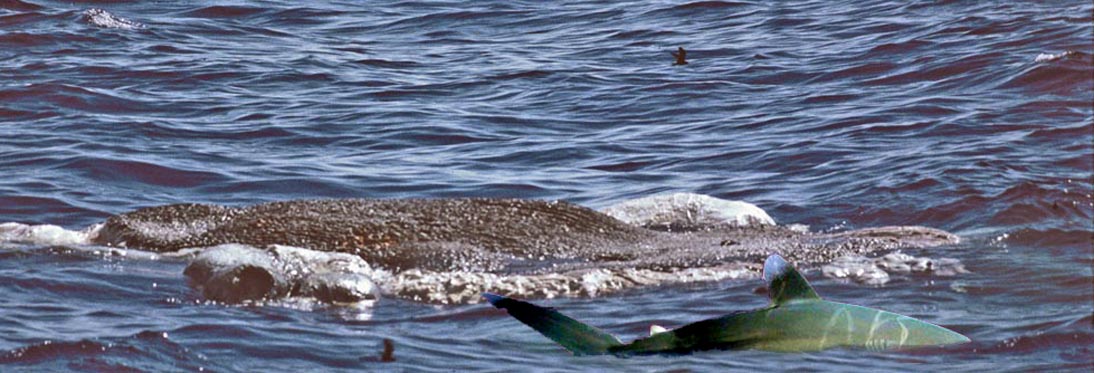 |
||||||
dead baleen whale, prey for Oceanic Whitetip [shark artwork added to photo]: 1 Aug 1989 at 21°17'N, 115°59' W © Don Roberson (above) |
||||||
Caribbean Reef Shark Carcharhinus perezi in Nov 1980 at San Salvador I., Bahamas © Don Roberson (below) |
||||||
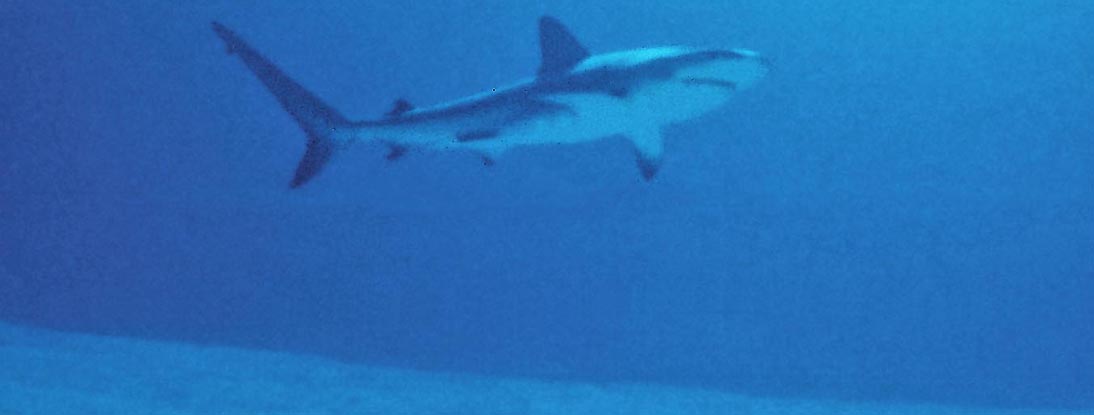 |
||||||
Other sharks: Although Quammen's list included just two sharks — and I follow that pattern here — the ISAF has implicated at least 42 shark species in a total of 980 attacks over the past 400 years. Many attacks go unrecorded or unidentified as to species (especially those of wartime ship sinkings). The ISAF estimates 70-100 shark attacks in a typical year, with perhaps 5-15 fatalities. Of those that can be attributed to species, three sharks are implicated in half of the attacks worldwide: Great White (35%), Tiger Shark Galeocerdo cuvier (12%), and Bull Shark Carcharhinus leucas (8%). Other large or aggressive species implicated include Great Hammerhead Sphyrna mokarran, Scalloped Hammerhead S. lewini, and Shortfin Mako Isurus oxyrinchus. Even smaller species, such as Galapagos Shark Carcharhinus galapagenis or Caribbean Reef Shark C. perezi (photo above) have been implicated in 'bump-and-bite' attacks. Yet, for all of those statistics, hundreds of divers and snorkelers swim peacefully with sharks every day. Many find that seeing a shark underwater is a wonderful and exhilarating experience; see Carwardine (2002 or updated versions) for information on when and where to go to see sharks.* Still, some of these are dangerous sharks. Tiger, Bull, or Hammerhead sharks could easily be considered among the 'monsters of god.' You don't have to gripe about my inclusion of Anaconda or Mugger Crocodile if you don't like those choices. Feel free to pick any big shark instead! I should add that the name of this page — "Two Fish and a Lizard" — is technically inaccurate. Ellis (1975) argues that sharks should not be considered "fish" in the evolutionary sense, since "fish" are not a monophyletic group. "Sharks," Ellis says, "are not bony fishes that took a wrong turn on the evolutionary road; they are a unique and distinct line that shows as noble a history as their teleost [bony fish] cousins." The genetic evidence apparently shows that cartilaginous "fishes," class Chondrichthyes, consisting of sharks, rays and chimaeras, appeared by about 395 million years ago. The bony "fishes," class Osteichthyes, have a bony skeleton rather than cartilage, and they first appeared in the fossil record about 416 million years ago. As different classes, sharks and bony fishes are as different from each other as birds are from snakes, so, in truth, sharks are not "fish" as we tend to visualize them. Still, in speaking of monsters, "two fish and lizard" has a nice ring to it, even if technically off-key. [Some fish can be dangerous in packs, such as piranhas in South America — some 30-60 species of omnivorous small fish in 3 genera. Fatal attacks most often involve the Red-bellied Piranha Pygocentrus nattereri of the Amazon Basin. Teddy Roosevelt wrote in his 1914 book Through the Brazilian Wilderness: "They are the most ferocious fish in the world. Even the most formidable fish, the sharks or the barracudas, usually attack things smaller than themselves. But the piranhas habitually attack things much larger than themselves. They will snap a finger off a hand incautiously trailed in the water; they mutilate swimmers—in every river town in Paraguay there are men who have been thus mutilated; they will rend and devour alive any wounded man or beast; for blood in the water excites them to madness." Likewise, the Goliath Tigerfish Hydrocynus goliath, found in the Congo River system and Lake Tanganyika, and some smaller relatives, are aggressive predators than hunt in packs and have attacked people. Yet none of these fish qualify as a "monster of god" because a single fish is neither an alpha predator nor a dangerous to life. Like wolves and hyenas, it is the pack that can terrify.] |
||||||
| * I do have some personal experience with some of these sharks. In the Pacific, I observed a 8' Hammerhead, possibly Great, next to our ship on 30 Oct 1989 at 1° N, 87°50' W [about 200 NE of the Galapagos], and another 15 Nov 1989 at 5°20'S, 94°10'W [500 mi W of northwest Peru]; and in the Atlantic a 5' Hammerhead, probably Scalloped, on 3 Sep 1982 some 20 mi offshore of Port Canaveral, Florida. | ||||||
Komodo Dragon on 21 Oct 1999 Rinca I., Indonesia © John Sullivan (below) |
||||||
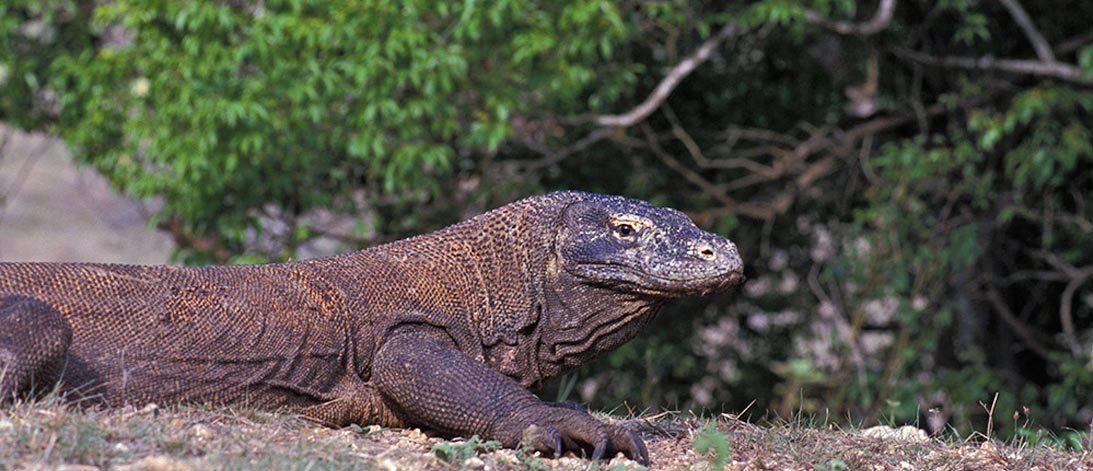 |
||||||
Komodo Dragon Varanus komodoensis is the world's largest lizard. It is a species of monitor endemic to a very few islands in the Lesser Sundas, Indonesia — primarily Komodo and nearby Rinca, both of which lie off the western tip of Flores. They swim well, so other islets may host them as well. Once thought to be an example of island gigantism, recent studies suggest that giant monitors were once a ubiquitous part of the subcontinental Eurasian and Australasian faunas more than 3.8 million years ago. Extinction played a pivotal role in the reduction of their ranges and diversity, leaving only only the Komodo taxa, termed Komodo Monitor by some, as an isolated long-term survivor (Burness et al. 2001, Hocknull et al. 2009). Komodo Dragon is largely a solitary, opportunistic, sit-and-wait ambush predator at the top of its food chain. Its maximum size is about 3m (10 ft) and it can weigh up to 70 kg (150 lbs). Large adults take large mammals, such as deer, but also consume a fair bit of carrion. Although they generally avoid humans, a few unprovoked attacks of predatory nature are documented (Auffenberg 1981). Attacks go for the throat, and when the prey is dead, large chunks of flesh are torn from the carcass and swallowed whole. There is very much a hierarchy in the wild, with larger dragons dominating. After wrestling battles between lizards of similar size, the loser generally retreats, although it has been known for the loser to be killed and eaten by the victor (Auffenberg 1981). It has been claimed that Komodo Dragons have a venomous bite, and three are poison glands in the lower jaw, but their biological significance is debated. There are also contesting views about whether their saliva has septic pathogens; see Ciofi (2004), Fry et al. (2009), and Goldstein et al. (2013). I have not yet seen a Komodo Dragon; I need to plan a trip to the Lesser Sundas. David Quammen visited Komodo during his research for his classic book The Song of the Dodo (1996). With a local guide, he sought to see the Dragon on his own terms, in the wild. Here is his account:
If
David Quammen himself can be attacked by a Komodo Dragon, what chance
to the rest of us have? Apparently the Indonesian park service
understands this now, and one is not allowed to venture away from the
packs of tourists in their planned regimen. John Sullivan describes his
1999 experience on his website [Wild Herps]
this way: "The highlight of our trip to Indonesia and the islands in
Komodo National Park was, of course, the legendary Komodo Dragon,
largest lizard in the world. And possibly the only lizard around that
occasionally eats people. We saw this mangrove-wanderer soon after we
got off the boat onto Rinca, the island neighboring Komodo." They saw
two " huge adults, maybe 8 feet long. The largest one ever reliably
measured was slightly over 10 feet long. The really big ones that we
saw spent most of their time lying about. Occasionally one would
sloooowly rise to its feet, instantly escalating the tension level of
any human observers. The third one [seen was] a young adult; big enough
to live on the ground. (Until the age of two or so they live primarily
in the trees, thus avoiding being eaten by the larger ones.) The
younger ones we saw were considerably more active than the huge ones;
they were generally wandering about tasting the scent of the air
constantly with their long forked tongues." |
||||||
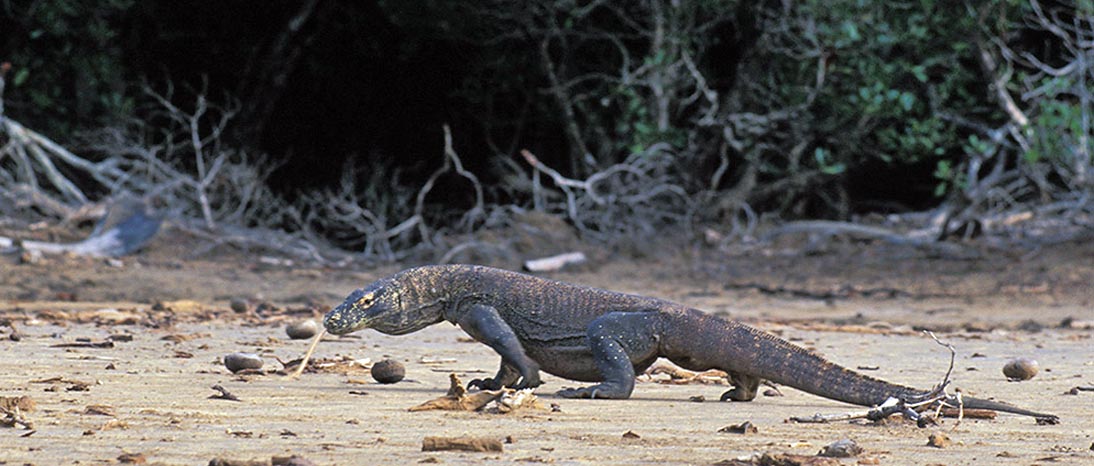 |
||||||
Komodo Dragon on 21 Oct 1999 Rinca I., Indonesia © John Sullivan (above) |
||||||
Click below for the next page of this project OR use these LINKS to the SPECIES PAGES
|
||||||
Photos: All photos © Don Roberson, except as otherwise attributed; all rights reserved. Literature cited:
|
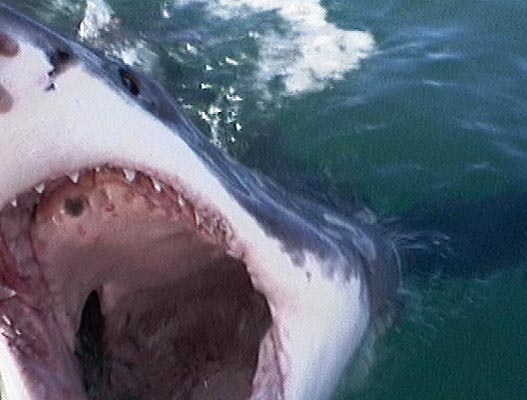 Great White Shark Carcharodon carcharias
is the largest of the dangerous sharks, with individuals recorded up to
6.4m (21 ft.) and 3175 km (7000 lbs). More typically, large adults are
3–5.5m (10-18 ft max). The Great White was, of course, the subject of
Peter Benchley's novel and the Steven Spielberg movie Jaws.
Many consider it to be the most feared predator on earth. [But not me
... I am much more afraid of large crocs and Polar Bears (see those
accounts). I would be willing to dive with Great Whites in clear water
outside a cage, except at my age, my diving days may be over.]
Great White Shark Carcharodon carcharias
is the largest of the dangerous sharks, with individuals recorded up to
6.4m (21 ft.) and 3175 km (7000 lbs). More typically, large adults are
3–5.5m (10-18 ft max). The Great White was, of course, the subject of
Peter Benchley's novel and the Steven Spielberg movie Jaws.
Many consider it to be the most feared predator on earth. [But not me
... I am much more afraid of large crocs and Polar Bears (see those
accounts). I would be willing to dive with Great Whites in clear water
outside a cage, except at my age, my diving days may be over.]